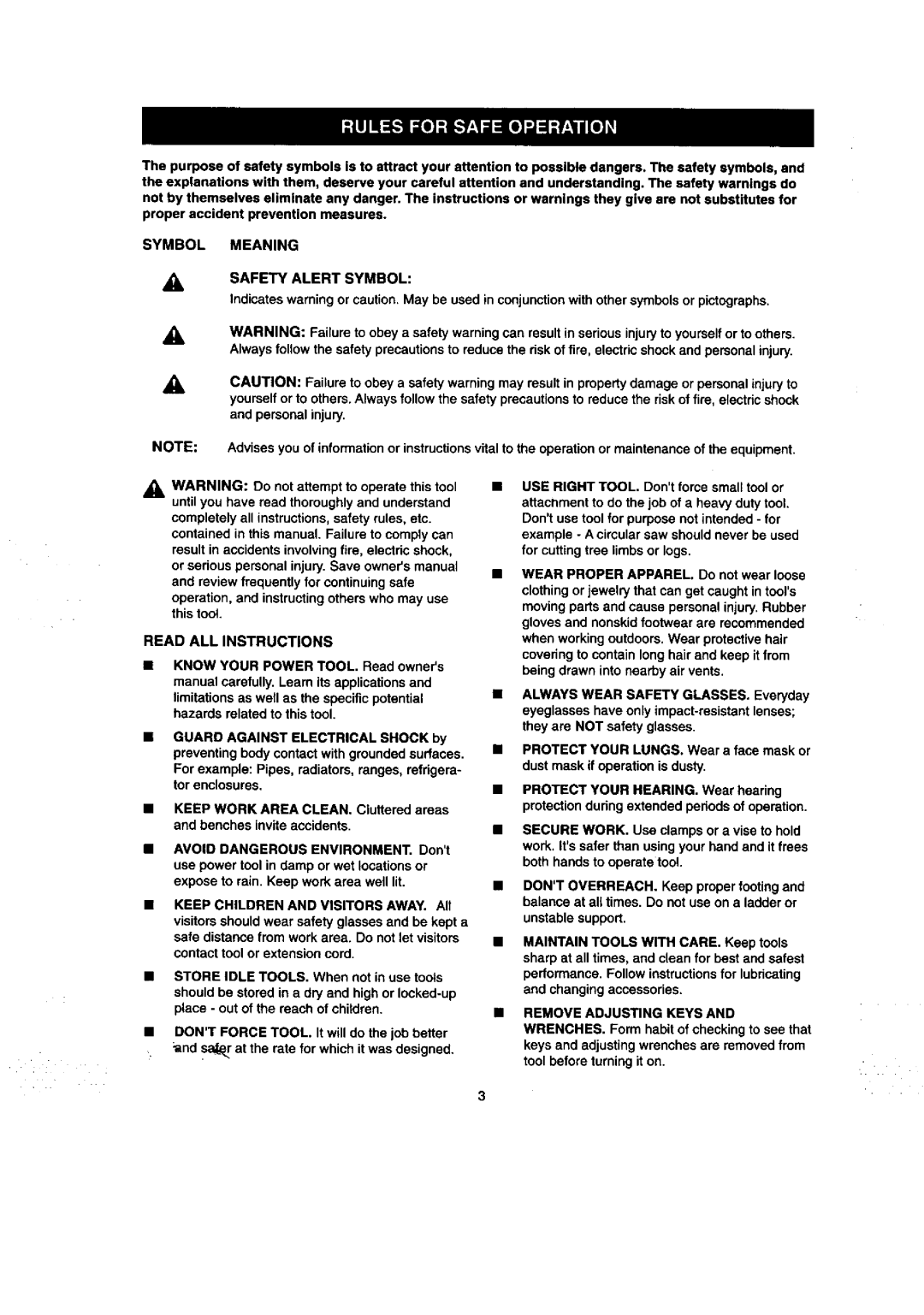
ThepurposeofsafetysymbolsistoattractyourattentiontopossibledangersThesafetysymbols,and.
theexplanationswiththem,deserveyourcarefulattentionandunderstandingThesafetywarningsdo.
notbythemselveseliminateanydangerTheinstructionsorwarningstheygivearenotsubstitutesfor.
properaccidentpreventionmeasures.
SYMBOL
A
A
A
MEANING
SAFETY ALERTSYMBOL:
Indi_teswamingorcaution.Maybeusedinconjunctionwithothersymbelsorpict_mphs.
WARNING: Failure to obey a safety warning can result in serious injuryto yourself or to others. Always follow the safety precautionsto reduce the riskof fire, electric shock and personal injury.
CAUTION: Failure to obey a safety warning may result in property damage or personal injuryto yourself or to others.Always follow the safety precautionsto reduce the risk of fire, electric shock and personal injury.
NOTE: | Advises you of informationor instructionsvital to the operationor maintenance of the equipment. | ||||
_k | WARNING: Do not attempt to operate thistool | • | USE RIGHT TOOL. Don'tforce small tool or | ||
| until you have read thoroughly and understand |
| attachment to do the job of a heavy duty tool. | ||
| completely all instructions,safety rules, etc. |
| Don'tuse tool for purpose not intended - for | ||
| contained in this manual. Failure to comply can |
| example - A circular saw should never be used | ||
| result in accidents involvingfire, electric shock, |
| for cutting tree limbs or logs. | ||
| or serious personal injury. Save owner'smanual |
| WEAR PROPER APPAREL. Do not wear loose | ||
| and review frequently for continuing safe |
| |||
|
| clothing or jewelry that can get caught in tool's | |||
| operation, and instructingothers who may use |
| |||
|
| moving parts and cause personal injury. Rubber | |||
| this tool. |
|
| ||
|
|
| gloves and nonskidfootwear are recommended | ||
|
|
|
| ||
READ ALL INSTRUCTIONS |
| when working outdoors. Wear protective hair | |||
| KNOW YOUR POWER TOOL. Read owner's |
| covering to contain long hair and keep it from | ||
|
| being drawn into nearby air vents. | |||
| manual carefully. Learn its applications and |
| |||
|
| ALWAYS WEAR SAFETY GLASSES. Everyday | |||
| limitations as well as the specific potential |
| |||
| hazards related to this tool. |
| eyeglasses | have only | |
| GUARD AGAINST ELECTRICAL SHOCK by |
| they are NOT safety glasses. | ||
|
| PROTECT YOUR LUNGS. Wear a face mask or | |||
| preventing body contact with grounded surfaces. |
| |||
|
| dust mask if operation is dusty. | |||
| For example: Pipes, radiators, ranges, refrigera- |
| |||
|
|
|
| ||
| tor enclosures, |
| PROTECT YOUR REARING. Wear hearing | ||
|
|
|
| ||
• | KEEP WORK AREA CLEAN. Cluttered areas |
| protectionduring extended periods of operation. | ||
| and benches invite accidents. |
| SECURE WORK. Use clamps or a vise to hold | ||
|
|
|
| ||
• | AVOID DANGEROUS ENVIRONMENT. Don't |
| work. It'ssafer than using your hand and it frees | ||
| use power tool in damp or wet locations or |
| both hands to operate tool. | ||
|
|
|
| ||
| expose to rain. Keep work area well lit. |
| DON'TOVERREACH. Keep proper footingand | ||
|
|
|
| ||
• | KEEP CHILDREN AND VISITORS AWAY. All |
| balance at all times. Do not use on a ladder or | ||
| unstable support. | ||||
| visitors should wear safety glasses and be kept a |
| |||
| safe distance from work area. Do not let visitors |
| • AINTAIN TOOLS WITH CARE. Keep tools | ||
| contact tool or extension cord. |
| |||
|
| sharp at all times, and clean for best and safest | |||
|
|
|
| ||
• | STORE IDLE TOOLS. When not in use tools |
| performance. Follow instructionsfor lubricating | ||
| should be stored in a dry and high or |
| and changing accessories. | ||
|
|
|
| ||
| place - out of the reach of children. |
| RE•OVE | ADJUSTING KEYS AND | |
• | DON'TFORCE TOOL. It will do the job better |
| WRENCHES. Form habit of checking to see that | ||
| ;and sa_r at the rate for wh ch it was designed. |
| keys and adjustingwrenches are removed from | ||
|
|
|
| ||
tool before turning it on.
3
